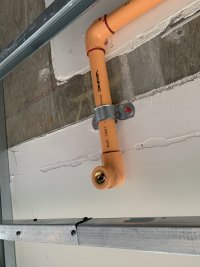Considering that CPVC pipe is shown, is the entire building protected by an NFPA 13R/13D system?
Per the OP, it is a high rise.
NFPA 13D is only for one and two family dwellings. Per IBC 903.3.1.2, a 13R system is not permitted in Group R occupancies greater than 4-stories or exceeding 60-ft. So...why is CPVC used?
903.3.1.2 NFPA 13R Sprinkler Systems
Automatic sprinkler systems in Group R occupancies up to and including four stories in height in buildings not exceeding 60 feet (18 288 mm) in height above grade plane shall be permitted to be installed throughout in accordance with NFPA 13R.
The number of stories of Group R occupancies constructed in accordance with Sections 510.2 and 510.4 shall be measured from the horizontal assembly creating separate buildings.
So, I guess my question is if the sprinkler system is even installed legally?


